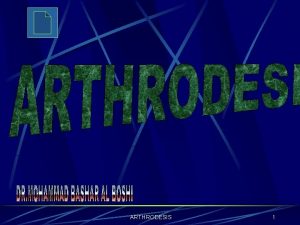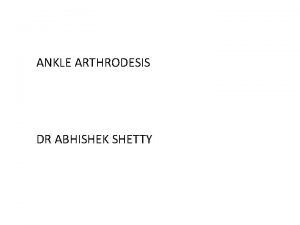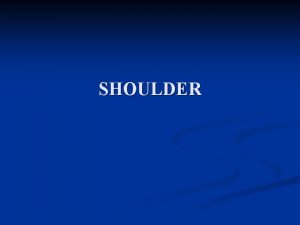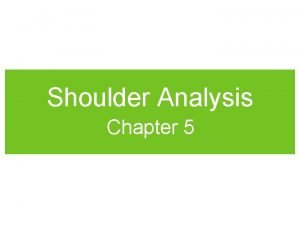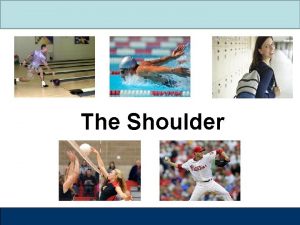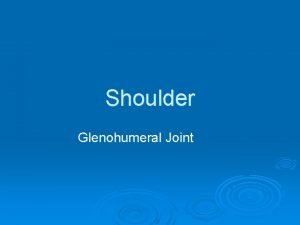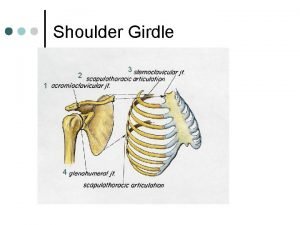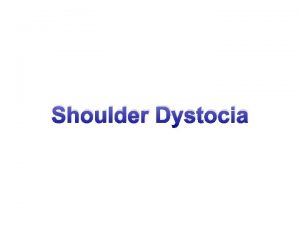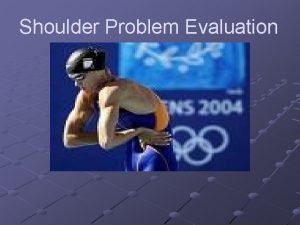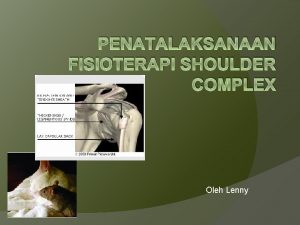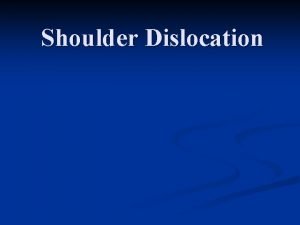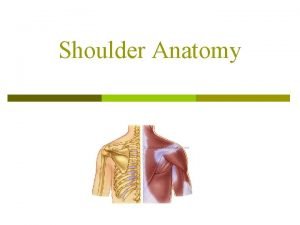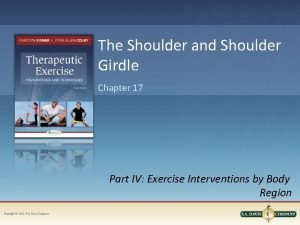ARTHRODESIS 1 ARTHRODESIS 2 INDICATIONS Indications for shoulder














































- Slides: 46

ARTHRODESIS 1

ARTHRODESIS 2

INDICATIONS Indications for shoulder fusion have diminished over the years because of: the excellent results of shoulder arthroplasty. the near elimination of poliomyelitis and tuberculosis. the improved techniques for shoulder stabilization. ARTHRODESIS 3

ARTHRODESIS 4

Contraindications Osteonecrosis. Charcot arthropathy(nonunion rate is high). Ipsilateral elbow fusion. Contralateral shoulder fusion. ARTHRODESIS 5

We agree that the position of rotation is the most critical factor in obtaining optimal function. ARTHRODESIS 6

ARTHRODESIS 7

SURGICAL TECHNIQUES the limited contact between the glenoid fossa and humeral head can be improved by including the acromion in the fusion mass. Firm internal fixation usually eliminates the need for bone grafting and external fixation. ARTHRODESIS 8

Used as graft COMPRESSION TECHNIQUES—EXTERNAL FIXATION TECHNIQUE 1 (Charnley and Houston) ARTHRODESIS 9

5 to 6 weeks cast 12 weeks ARTHRODESIS 10

COMPRESSION TECHNIQUES—INTERNAL FIXATION TECHNIQUE 1 (Cofield) ARTHRODESIS 11

45 Degrees TECHNIQUE 1 (Cofield) ARTHRODESIS spica cast 12 to 16 weeks 12

AFTERTREATMENT: A pelvic band extending from the nipples to the pubic symphysis is applied. With the elbow flexed 90 degrees, a cylinder cast is applied to the upper extremity. The extremity is suspended by two wooden struts, or a cock-up wrist splint is used. At 1 to 2 weeks after surgery, a plastic shoulder spica cast is applied and worn until union is achieved, 12 to 16 weeks after surgery. ARTHRODESIS 13

TECHNIQUE 2 (Uematsu) Position 20 degrees of abduction, 30 degrees of flexion, and 40 degrees of internal rotatio Used as graft A cast 3 months ARTHRODESIS 14

the distal acromion as avascularized graft A shoulder spica 8 -10 weeks TECHNIQUE 3 (Mohammed) ARTHRODESIS 15

Apply bone grafts No cast TECHNIQUE 4 (AO Group) ARTHRODESIS 16

60 D 30 Position degrees of flexion, 30 degrees of abduction, and 30 degrees of internal rotation. Do not osteotomize the acromion A shoulder spica cast 6 weeks TECHNIQUE 5 (Richards et al. ) ARTHRODESIS 17

ARTHRODESIS 18

ARTHRODESIS 19

ARTHRODESIS 20

POSITION For unilateral arthrodesis of the elbow, a position of 90 degrees of flexion is desirable. Bilateral elbow arthrodesis rarely is indicated because of resultant functional limitations. If indicated, one elbow should be placed in 110 degrees of flexion to permit the patient to reach the mouth and the other should be placed in 65 degrees to aid in personal hygiene. ARTHRODESIS 21

AGraft: 1. 5 x 9 cm Fitting cast 8 weeks TECHNIQUE 1 (Steindler) ARTHRODESIS 22

Grafts: 8 mm x 7. 5 -10 cm Fitting cast 8 weeks TECHNIQUE 2 (Brittain) ARTHRODESIS 23

Fitting cast 8 weeks TECHNIQUE 3 (Staples) ARTHRODESIS 24

Technique for fusion in tuberculous arthritis of elbow. TECHNIQUE 4(Arafiles) ARTHRODESIS use the resected epicondylar and olecranon fragments as bone grafts a long arm cast for 3 months 25

The fixator and pins 6 to 8 weeks a long arm cast until the arthrodesis is solid TECHNIQUE 5 (Müller et al. ) ARTHRODESIS 26

The plate and screws 1 year only Apply bone graft TECHNIQUE 6 (Spier) The most common indication was a high-energy, open, infected injury with associated bone loss. ARTHRODESIS 27

Complications of elbow arthrodesis include: Delayed union. Nonunion. Malunion. Neurovascular injury. Painful prominent hardware. Skin breakdown. ARTHRODESIS 28

ARTHRODESIS 29

ARTHRODESIS 30

Contraindications include : An open physis of the distal radius( The distal radial physis close approximately 17 years of age). After partial destruction of the physis , the remaining part may be excised to prevent unequal growth. An elderly patient with a sedentary lifestyle, especially if the nondominant wrist is involved. ARTHRODESIS 31

POSITION Usually 10 to 20 degrees of extension (dorsiflexion) with the long axis of the third metacarpal shaft aligned with the long axis of the radial shaft (allow maximum grasping strength). In general, neutral to 5 degrees of ulnar deviation is preferred. If bilateral wrist fusions are indicated, the positions of the wrists should be determined by the needs of the patient( The neutral position). ARTHRODESIS 32

The straight plate is employed when a large intercalary graft is required for a traumatic or tumorous defect. The short carpal bend is used in small wrists and those in which the proximal row has been resected. The longer carpal bend is used in large wrists. ARTHRODESIS 33

TECHNIQUE 1 (AO Group) cancellous bone harvested from the excised bone A cast (10 to 12 weeks) ARTHRODESIS 34

80% Supporting the fusion site with Kirschner wires or staples. cast or splint for 12 to 16 weeks bone graft is not. necessary TECHNIQUE 2 (Louis et al. ) ARTHRODESIS 35

cast or splint for 12 to 16 weeks 2. 5 x 4 cm , If the wrist is unstable insert a nonthreaded Kirschner wire TECHNIQUE 3 (Haddad and Riordan) ARTHRODESIS 36

Place an outer cortical piece of iliac bone graft Cast 6 -8 weeks TECHNIQUE 4 (Watson and Vendor) ARTHRODESIS 37

ARTHRODESIS 38

ARTHRODESIS 39

INDICATIONS Damaged by injury or disease. Pain. Deformity. Instability makes motion a liability rather than an asset. Arthrodesis is used most often for the proximal interphalangeal joint because motion in this joint is so important. When the metacarpophalangeal joint is destroyed, if good muscle strength is present, arthroplasty is indicated more often than arthrodesis. ARTHRODESIS 40

POSITION The metacarpophalangeal joint should be fixed in 20 to 30 degrees of flexion. The proximal interphalangeal joints should be fixed from 25 degrees of flexion in the index finger to almost 40 degrees in the small finger (less flexion in the radial fingers than in the ulnar fingers). The distal interphalangeal joints are fixed in 15 to 20 degrees of flexion. ARTHRODESIS 41

Ball-socket Or Cup-cone Splint 2 -3 days TECHNIQUE (Stern et al. ; Segmüller, Modified) ARTHRODESIS 42

A , Phalangeal osteotomy. B , Hole for 25 - or 26 gauge stainless steel wire made through middle phalangeal base dorsal to midaxial line. C C, Retrograde insertion of 0. 028 -or 0. 035 -inch Kirschner wire into proximal phalanx. D , Kirschner wire driven into anterior cortex of middle phalanx. E , Figure-eight tension band created and tightened. Tension band arthrodesis ARTHRODESIS 43

A, Anteroposterior and lateral views of crossed Kirschner wires. B, Anteroposterior and lateral views of interfragmentary wire and longitudinal Kirschner wires. C, Anteroposterior and lateral views of Herbert screw ARTHRODESIS 44

ARTHRODESIS 45

 Arthrodesis
Arthrodesis Arthrodesis
Arthrodesis Epiteltyper
Epiteltyper Brant karttecken
Brant karttecken Formel för lufttryck
Formel för lufttryck Matte större än tecken
Matte större än tecken Elektronik för barn
Elektronik för barn Särskild löneskatt för pensionskostnader
Särskild löneskatt för pensionskostnader Borra hål för knoppar
Borra hål för knoppar Bris för vuxna
Bris för vuxna Mat för unga idrottare
Mat för unga idrottare Smärtskolan kunskap för livet
Smärtskolan kunskap för livet Trög för kemist
Trög för kemist Argument för teckenspråk som minoritetsspråk
Argument för teckenspråk som minoritetsspråk Datorkunskap för nybörjare
Datorkunskap för nybörjare Delegerande ledarstil
Delegerande ledarstil Ellika andolf
Ellika andolf Returpilarna
Returpilarna Rita perspektiv
Rita perspektiv Toppslätskivling effekt
Toppslätskivling effekt Redogör för vad psykologi är
Redogör för vad psykologi är Claes martinsson
Claes martinsson Lek med former i förskolan
Lek med former i förskolan Offentlig förvaltning
Offentlig förvaltning Lyrik texte
Lyrik texte Ledarskapsteorier
Ledarskapsteorier Plagg i gamla rom
Plagg i gamla rom Personlig tidbok
Personlig tidbok Orubbliga rättigheter
Orubbliga rättigheter Formuö
Formuö Ministerstyre för och nackdelar
Ministerstyre för och nackdelar Big brother rösta
Big brother rösta Tillitsbaserad ledning
Tillitsbaserad ledning Kanaans land
Kanaans land Sju för caesar
Sju för caesar Tack för att ni lyssnade bild
Tack för att ni lyssnade bild Nyckelkompetenser för livslångt lärande
Nyckelkompetenser för livslångt lärande Gibbs reflekterande cykel
Gibbs reflekterande cykel Shingelfrisyren
Shingelfrisyren Informationskartläggning
Informationskartläggning Stål för stötfångarsystem
Stål för stötfångarsystem Centrum för kunskap och säkerhet
Centrum för kunskap och säkerhet Verktyg för automatisering av utbetalningar
Verktyg för automatisering av utbetalningar Vishnuismen
Vishnuismen Kolopskopi
Kolopskopi I gullregnens månad
I gullregnens månad Inköpsprocessen steg för steg
Inköpsprocessen steg för steg
